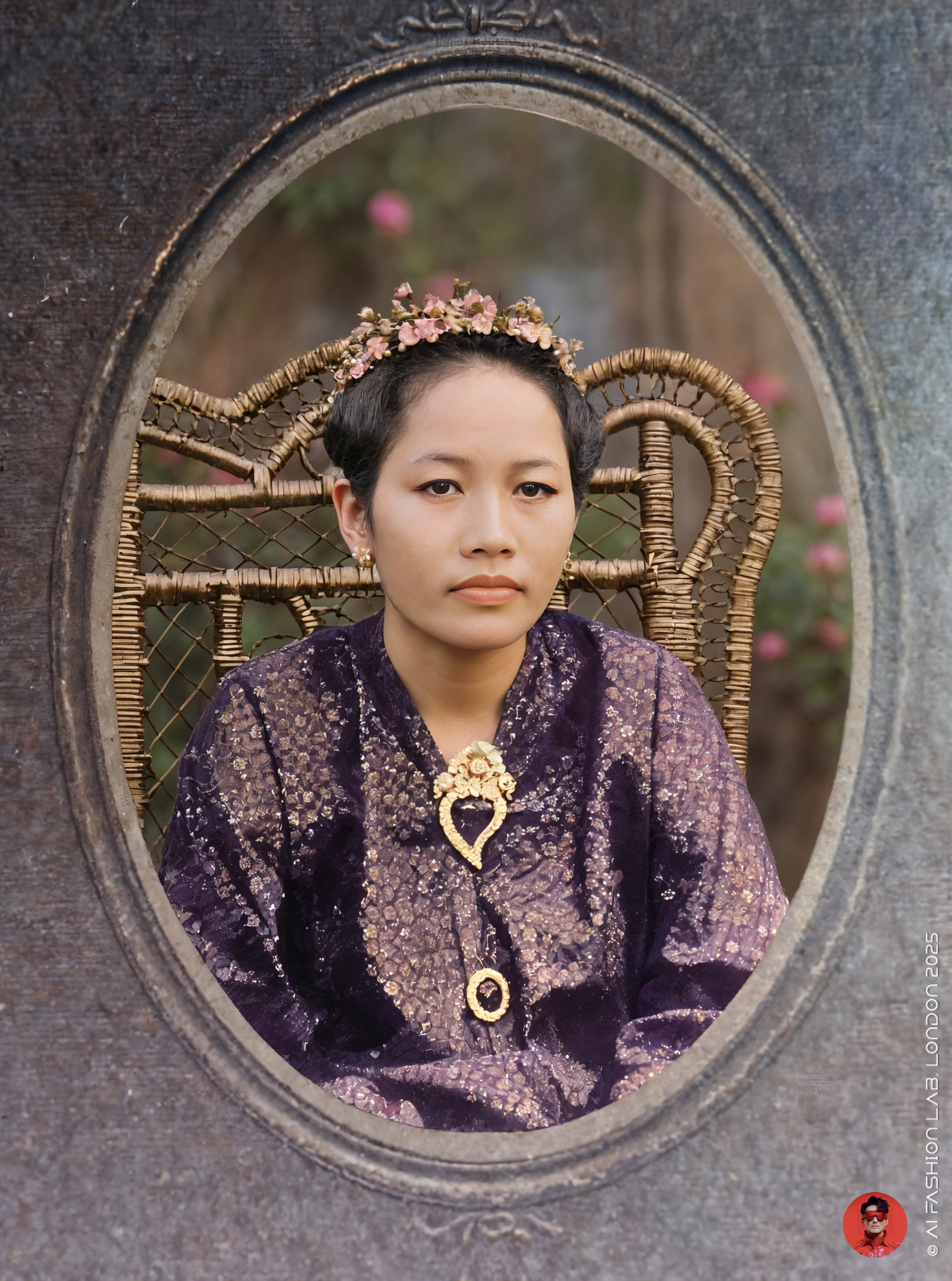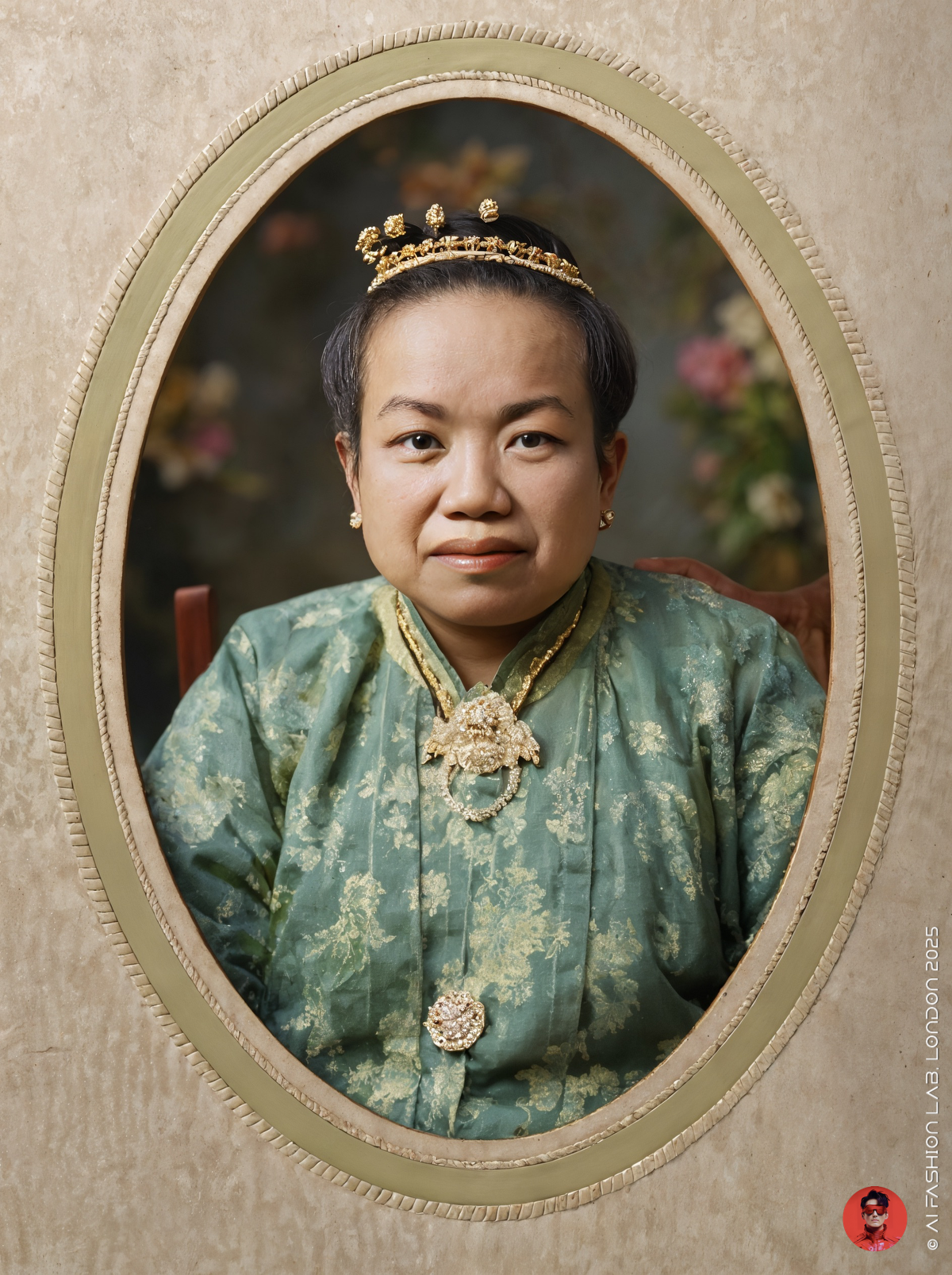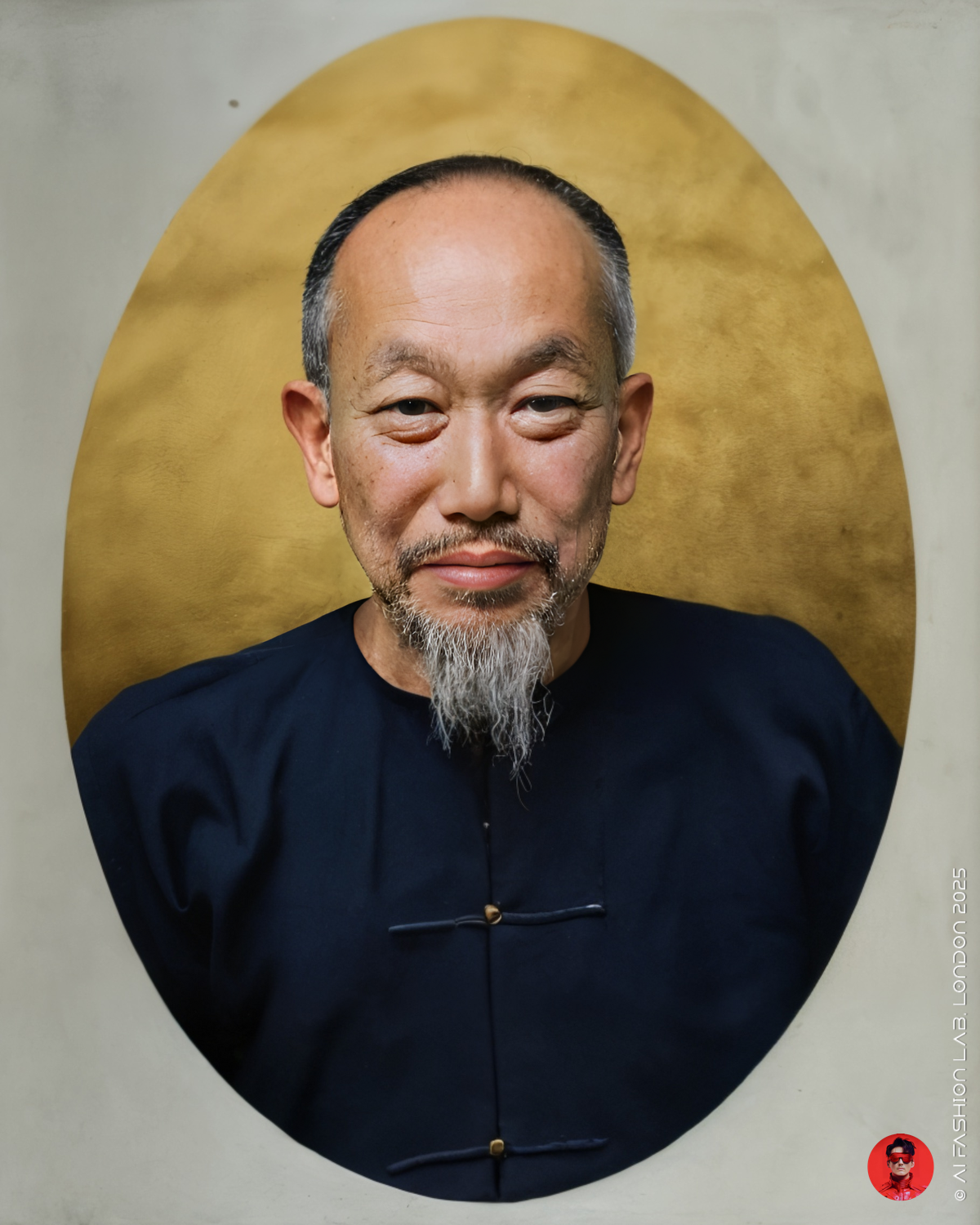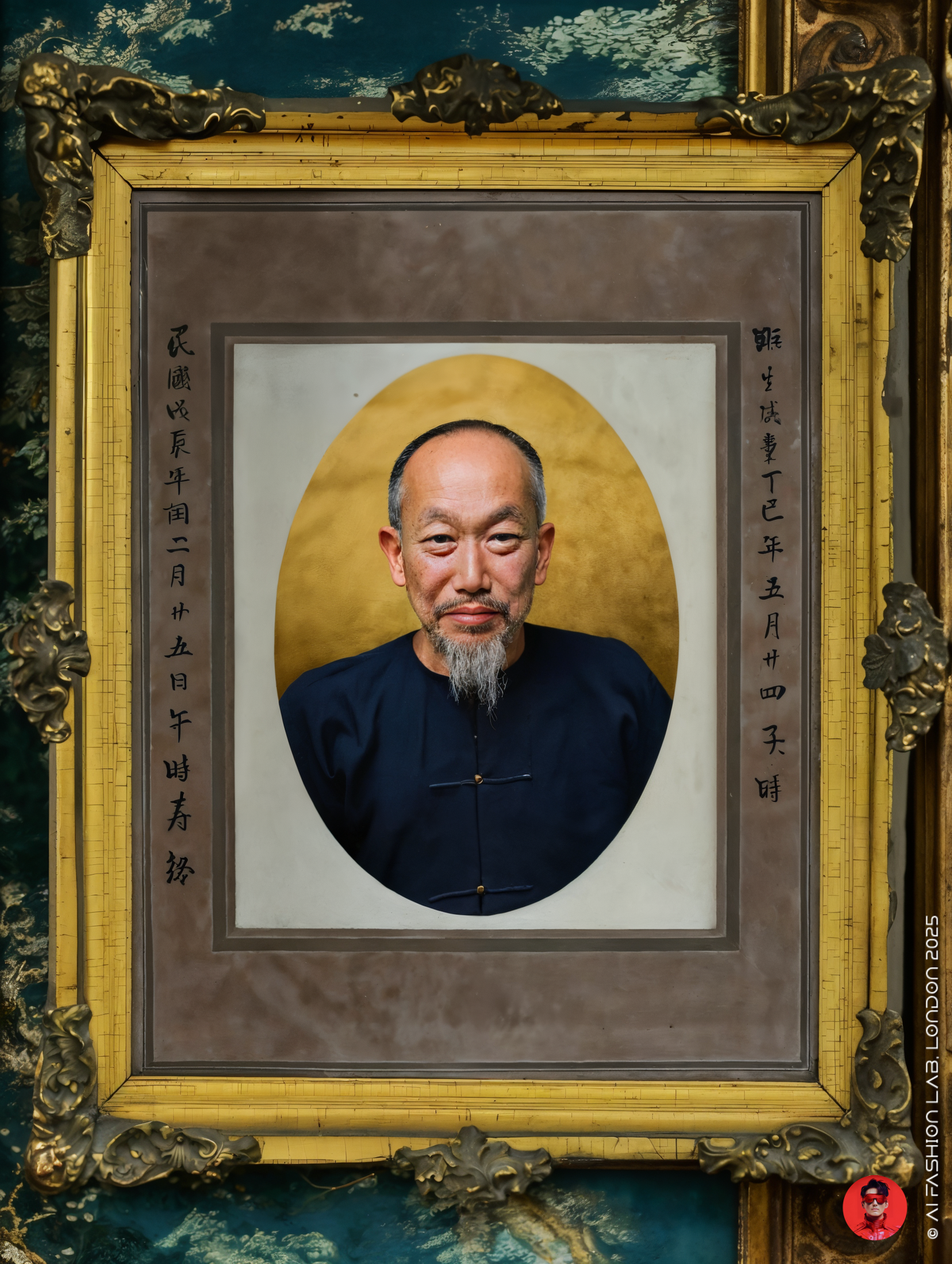บุคคลสำคัญในระนองในอดีต
นางฉ่ายอ่อง ณ ระนอง ภรรยาของพระยาดำรงสุจิตมหิศรภักดี (คอยู่หงี่ ณ ระนอง) ถ่ายเมื่อ พ.ศ. ๒๔๕๒ (ค.ศ. 1909 สมัยรัชกาลที่ ๕) (ภาพจากบ้านเทียนสือ นายศุภพรพงษ์ชัย พรพงษ์ เอื้อเฟื้อภาพ)
ภาพคอลเล็คชันนี้ได้รับการบูรณะด้วย AI เป็นภาพของต้นตระกูลของบุคคลสำคัญในระนอง ด้วยความร่วมมือระหว่าง AI Fashion Lab และ #พิพิธภัณฑ์จังหวัดระนอง ซึ่งจัดทำขึ้นเพื่อรำลึกและยกย่องคุณูปการของบุคคลสำคัญในระนองในอดีต ภาพทั้งหมดมาจากสมัยรัชกาลที่ ๕ ตอนปลาย ถึงสมัยรัชกาลที่ ๖ ตอนกลาง คอลเล็คชั่นนี้เป็นการบูรณะรูปถ่ายขาวดำโบราณให้คมชัดเหมือนรูปถ่ายแบบสามมิติ และบางภาพเป็นการสร้างสรรค์รูปเหมือนบุคคลในแบบสามมิติจากภาพเขียนดินสอเครยอน
บุคคลในภาพ ตามลำดับจากรูปแรก
นางฉ่ายอ่อง ณ ระนอง ภรรยาของพระยาดำรงสุจิตมหิศรภักดี (คอยู่หงี่ ณ ระนอง) ถ่ายเมื่อ พ.ศ. ๒๔๕๒ (ค.ศ. 1909 สมัยรัชกาลที่ ๕) (ภาพจากบ้านเทียนสือ นายศุภพรพงษ์ชัย พรพงษ์ เอื้อเฟื้อภาพ)
นางเลี่ยนฮั้ว อนันตโชค (ลิ่มตั้ง) ภาพยุค ๒๔๖๐ (ค.ศ. 1917 สมัยรัชกาลที่ ๖) (ภาพจากบ้านรัตน์นราทร นายสุพล รัตน์นราทร เอื้อเฟื้อภาพ)
ภาพต้นฉบับเป็นภาพเขียนดินสอเครยอนของนายบุ่นตุ่ย ลิ่มตั้ง ผู้เป็นต้นสกุล ลิ่มตั้ง บิดาของขุนรัตน์นราทร (จิ้นย่าว ลิ่มตั้ง) อดีตกำนันตำบลเขานิเวศน์ ภาพยุค ๒๔๖๐ (ค.ศ. 1917 สมัยรัชกาลที่ ๖) (สมบัติของบ้านรัตน์นราทร นายสุพล รัตน์นราทร เอื้อเฟื้อภาพ)
ภาพต้นฉบับเป็นภาพเขียนดินสอเครยอนของหลวงพิทักษ์ภักดีกิจกุศล หรือ “เถ้าแก่ม้อ แซ่ลิ่ม” อดีตนายอำเภอคนแรกของอำเภอกระบุรี ภาพยุค ๒๔๖๐ (ค.ศ. 1917 สมัยรัชกาลที่ ๖) (สมบัติของโรงเรียนธรรมรัตน์ นางสาวกรรณิการ์ นิยมไทย เอื้อเฟื้อภาพ)
นายบัน ลิ่มเฮ่งฮั่น (นั่ง) ต้นตระกูลลิ่มศิลา และนายอิ่วซิ่น ลิ่มศิลา ชาวทับหลี ตำบลมะมุ อำเภอกระบุรี ถ่ายเมื่อ พ.ศ. ๒๔๕๒ (ค.ศ. 1909 สมัยรัชกาลที่ ๕) (ภาพจากบ้านขุนมะมุไมตรี นายบูรณะ ลิ่มศิลา เอื้อเฟื้อภาพ)
บุรุษในภาพสวมเสื้อและกางเกงแบบจีนที่เห็นในภาพ เรียกว่า
เสื้อ“หม่ากว้า” (马褂) หรือบางทีก็เรียกว่า เสื้อคอกลมผ่าหน้าแบบจีน เป็นเสื้อแบบสั้น แขนยาว คอกลม กลัดกระดุมข้างหน้า โดยกระดุมจะเป็นแบบกระดุมเชือกปมปักบนผ้า ภาษาจีนเรียกว่ากระดุมแบบถาด (盘扣)
กางเกงขาก๊วย มักตัดจากผ้าแพรหรือผ้าฝ้าย ขากว้าง สวมกับเสื้อ“หม่ากว้า” (马褂)
ในช่วงปลายคริสต์ศตวรรษที่ 19 ถึงต้นคริสต์ศตวรรษที่ 20 ชุดลักษณะนี้เป็นเครื่องแต่งกายมาตรฐานของชายจีนโพ้นทะเล รวมถึงชาวจีนในสยาม โดยมักสวมกางเกงหลวมขากว้างสีเข้มกับเสื้อสีอ่อน และเสื้อหม่าเจี่ย (马甲) หรือเสื้อกั๊ก ทับด้านนอกหากเป็นโอกาสทางการ
สตรีในภาพสวม เสื้อย่าหยา ซึ่งเป็นเครื่องแต่งกายสตรีที่เกี่ยวข้องกับวัฒนธรรมและกลุ่มชาติพันธุ์ เพอรานากัน (Peranakan) หรือที่รู้จักกันในชื่อ บาบ๋า–ย่าหยา (Baba–Nyonya) กลุ่มชนนี้เป็นลูกหลานของชายชาวจีนที่แต่งงานกับหญิงพื้นเมืองในแถบคาบสมุทรมลายูและหมู่เกาะอินโดนีเซีย คำว่า “เพอรานากัน” ในภาษามลายูมีความหมายว่า “เกิดที่นี่” สื่อถึงรากเหง้าและอัตลักษณ์ที่ผูกพันกับถิ่นฐานท้องถิ่น
เสื้อย่าหยา (เคบายา – Kebaya) เป็นเสื้อผ้าสตรีในวัฒนธรรมเปอรานากันที่ผสมผสานอิทธิพลจากทั้งวัฒนธรรมจีนและมลายู ตัวเสื้อมักตัดเย็บจากผ้าเนื้อละเอียด เช่น ผ้าไหม ผ้าซาติน หรือผ้าลูกไม้ และติดด้านหน้าด้วยชุดเข็มกลัดสามชิ้นที่เรียกว่า kerongsang ในประเทศไทย โดยเฉพาะในภาคใต้ เช่น จังหวัดระนอง และภูเก็ต เสื้อชนิดนี้เป็นที่รู้จักในชื่อ เสื้อเคบายา และถือเป็นส่วนหนึ่งของมรดกทางวัฒนธรรมบาบ๋า–ย่าหยาที่สำคัญ
This collection has been restored using AI and features portraits of the founding ancestors of notable families in Ranong. It is a collaboration between AI Fashion Lab and the Ranong Provincial Museum, created to commemorate and honour the contributions of prominent figures in Ranong’s history. The images date from the late reign of King Rama V to the mid-reign of King Rama VI. This collection restores old black-and-white photographs into sharp, lifelike images with a three-dimensional photographic quality, while some portraits are creative 3D reconstructions from original crayon drawings.
Individuals in the photographs, in order from the first image:
Mrs. Chai-Ong Na Ranong (นางฉ่ายอ่อง ณ ระนอง), wife of Phraya Damrongsujitmahisornphakdi (พระยาดำรงสุจิตมหิศรภักดี) (Kho Yu-Hngi Na Ranong / คอยู่หงี่ ณ ระนอง), photographed in 1909 (R.E. 2452, during the reign of King Rama V). (From the Tiansue House Collection, courtesy of Mr. Suppapornpongchai Phonpong / นายศุภพรพงษ์ชัย พรพงษ์)
Mrs. Lian-Hua Anantachoke (นางเลี่ยนฮั้ว อนันตโชค) (Lim Tang / ลิ่มตั้ง), c. 1917 (R.E. 2460, during the reign of King Rama VI). (From the Rattanarathorn House Collection, courtesy of Mr. Suphon Rattanarathorn / นายสุพล รัตน์นราทร)
Original image: a crayon portrait of Mr. Bun-Tui Lim Tang (นายบุ่นตุ่ย ลิ่มตั้ง), founder of the Lim Tang family and father of Khun Rattanarathorn (ขุนรัตน์นราทร) (Jin-Yao Lim Tang / จิ้นย่าว ลิ่มตั้ง), former Kamnan of Khao Niwet Subdistrict, c. 1917 (R.E. 2460, during the reign of King Rama VI). (From the Rattanarathorn House Collection, courtesy of Mr. Suphon Rattanarathorn / นายสุพล รัตน์นราทร)
Original image: a crayon portrait of Luang Phitakphakdikitgusan (หลวงพิทักษ์ภักดีกิจกุศล), or “Kao Kae Mo Sae Lim” (เก้าแก่ม้อ แซ่ลิ่ม), the first district chief officer (nai amphoe) of Kra Buri, c. 1917 (R.E. 2460, during the reign of King Rama VI). (From the Thammarat School Collection, courtesy of Miss Kannika Niyomthai / นางสาวกรรณิการ์ นิยมไทย)
Mr. Ban Lim-Heng-Han (นายบัน ลิ่มเฮ่งฮั่น) (seated), founder of the Limsila family (ลิ่มศิลา), and Mr. Iu-Xin Limsila (นายอิ่วซิ่น ลิ่มศิลา), residents of Thap Li, Mamu Subdistrict, Kra Buri District, photographed in 1909 (R.E. 2452, during the reign of King Rama V). (From the Khun Mam Maitri House Collection, courtesy of Mr. Burana Limsila / นายบูรณะ ลิ่มศิลา)
Men’s Clothing in the Photographs
The men are wearing traditional Chinese attire, consisting of:
Ma Gua (马褂 / หม่ากว้า): a short, long-sleeved Chinese jacket with a round collar, fastened at the front with frog buttons (盘扣 / กระดุมเชือกปมปักบนผ้า).
Kha Kuai trousers (ขาก๊วย): loose, wide-legged trousers usually made from silk or cotton, worn with the ma gua.
From the late 19th to the early 20th century, this combination was standard dress for overseas Chinese men, including Chinese residents in Siam, typically pairing dark wide trousers with a light-coloured shirt and, for formal occasions, a ma gua worn as an outer jacket.
Women’s Clothing in the Photographs
The women are wearing seua yaya (เสื้อยะยา), a traditional women’s blouse associated with the Peranakan (เพอรานากัน) or Baba–Nyonya (บาบ๋า–ย่าหยา) community—descendants of Chinese men who married local Malay women in the Malay Peninsula and Indonesian Archipelago. The word Peranakan in Malay means “born here,” reflecting a locally rooted identity.
The Kebaya (เคบายา) in Peranakan culture blends Chinese and Malay influences, typically tailored from fine fabrics such as silk, satin, or lace, and fastened at the front with a set of three ornate brooches known as kerongsang (เครองซัง). In Thailand, particularly in southern provinces such as Ranong (ระนอง) and Phuket (ภูเก็ต), this garment is known as the seua kebaya (เสื้อเคบายา) and is regarded as an important part of the Baba–Nyonya cultural heritage.
#aifashionlab #AI #aiartist #aiart #aifashion #aifashiondesign #aifashionstyling #aifashiondesigner #fashion #fashionhistory #historyoffashion #fashionstyling #fashionphotography #digitalfashion #digitalfashiondesign #digitalcostumedesign #digitaldesign #digitalaiart #ThaiFashionHistory #ThaiFashionAI #thailand #UNESCO #พิพิธภัณฑ์จังหวัดระนอง


















